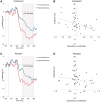Dispositional mindfulness and the attenuation of neural responses to emotional stimuli
- PMID: 22253259
- PMCID: PMC3541486
- DOI: 10.1093/scan/nss004
Dispositional mindfulness and the attenuation of neural responses to emotional stimuli
Abstract
Considerable research has disclosed how cognitive reappraisals and the modulation of emotional responses promote successful emotion regulation. Less research has examined how the early processing of emotion-relevant stimuli may create divergent emotional response consequences. Mindfulness--a receptive, non-evaluative form of attention--is theorized to foster emotion regulation, and the present study examined whether individual differences in mindfulness would modulate neural responses associated with the early processing of affective stimuli. Focus was on the late positive potential (LPP) of the event-related brain potential to visual stimuli varying in emotional valence and arousal. This study first found, replicating past research, that high arousal images, particularly of an unpleasant type, elicited larger LPP responses. Second, the study found that more mindful individuals showed lower LPP responses to high arousal unpleasant images, even after controlling for trait attentional control. Conversely, two traits contrasting with mindfulness--neuroticism and negative affectivity--were associated with higher LPP responses to high arousal unpleasant images. Finally, mindfulness was also associated with lower LPP responses to motivationally salient pleasant images (erotica). These findings suggest that mindfulness modulates neural responses in an early phase of affective processing, and contribute to understanding how this quality of attention may promote healthy emotional functioning.
Figures


Similar articles
-
Differential effects of state and trait mindfulness on the late positive potential.Emotion. 2018 Dec;18(8):1128-1141. doi: 10.1037/emo0000383. Epub 2017 Nov 27. Emotion. 2018. PMID: 29172619
-
Emotional modulation of attention affects time perception: evidence from event-related potentials.Acta Psychol (Amst). 2014 Jun;149:148-56. doi: 10.1016/j.actpsy.2014.02.008. Epub 2014 Mar 18. Acta Psychol (Amst). 2014. PMID: 24656420
-
Neuronal generator patterns at scalp elicited by lateralized aversive pictures reveal consecutive stages of motivated attention.Neuroimage. 2016 Nov 15;142:337-350. doi: 10.1016/j.neuroimage.2016.05.059. Epub 2016 Jun 2. Neuroimage. 2016. PMID: 27263509 Free PMC article.
-
Mindfulness Meditation: Impact on Attentional Control and Emotion Dysregulation.Arch Clin Neuropsychol. 2021 Oct 13;36(7):1283-1290. doi: 10.1093/arclin/acab053. Arch Clin Neuropsychol. 2021. PMID: 34651648 Free PMC article. Review.
-
The mindful brain and emotion regulation in mood disorders.Can J Psychiatry. 2012 Feb;57(2):70-7. doi: 10.1177/070674371205700203. Can J Psychiatry. 2012. PMID: 22340146 Free PMC article. Review.
Cited by
-
Distinct Mindfulness States Produce Dissociable Effects on Neural Markers of Emotion Processing: Evidence From the Late Positive Potential.Biol Psychiatry Glob Open Sci. 2024 Jun 29;4(5):100357. doi: 10.1016/j.bpsgos.2024.100357. eCollection 2024 Sep. Biol Psychiatry Glob Open Sci. 2024. PMID: 39183744 Free PMC article.
-
Clarifying the relationship between mindfulness and executive attention: a combined behavioral and neurophysiological study.Soc Cogn Affect Neurosci. 2019 Feb 13;14(2):205-215. doi: 10.1093/scan/nsy113. Soc Cogn Affect Neurosci. 2019. PMID: 30535128 Free PMC article.
-
Functional Connectivity Within the Executive Control Network Mediates the Effects of Long-Term Tai Chi Exercise on Elders' Emotion Regulation.Front Aging Neurosci. 2018 Oct 23;10:315. doi: 10.3389/fnagi.2018.00315. eCollection 2018. Front Aging Neurosci. 2018. PMID: 30405392 Free PMC article.
-
Indices of association between anxiety and mindfulness: a guide for future mindfulness studies.Personal Neurosci. 2019 Oct 24;2:e9. doi: 10.1017/pen.2019.12. eCollection 2019. Personal Neurosci. 2019. PMID: 32435744 Free PMC article. Review.
-
Mindfulness may both moderate and mediate the effect of physical fitness on cardiovascular responses to stress: a speculative hypothesis.Front Physiol. 2014 Mar 25;5:105. doi: 10.3389/fphys.2014.00105. eCollection 2014. Front Physiol. 2014. PMID: 24723891 Free PMC article.
References
-
- Arch JJ, Craske MG. Mechanisms of mindfulness: emotion regulation following a focused breathing induction. Behaviour Research and Therapy. 2006;44:1849–58. - PubMed
-
- Baer RA. Mindfulness training as a clinical intervention: a conceptual and empirical review. Clinical Psychology: Science and Practice. 2003;10:125–43.
-
- Baer RA, Smith GT, Hopkins J, Krietemeyer J, Toney L. Using self-report assessment methods to explore facets of mindfulness. Assessment. 2006;13:27–45. - PubMed
-
- Barnes S, Brown KW, Krusemark E, Campbell WK, Rogge RD. The role of mindfulness in romantic relationship satisfaction and responses to relationship stress. Journal of Marital and Family Therapy. 2007;33:482–500. - PubMed
-
- Brown KW, Cordon SL. Toward a phenomenology of mindfulness: subjective experience and emotional correlates. In: Didonna F, editor. Clinical Handbook of Mindfulness. New York: Springer; 2009. pp. 59–81.
MeSH terms
LinkOut - more resources
Full Text Sources
Miscellaneous

